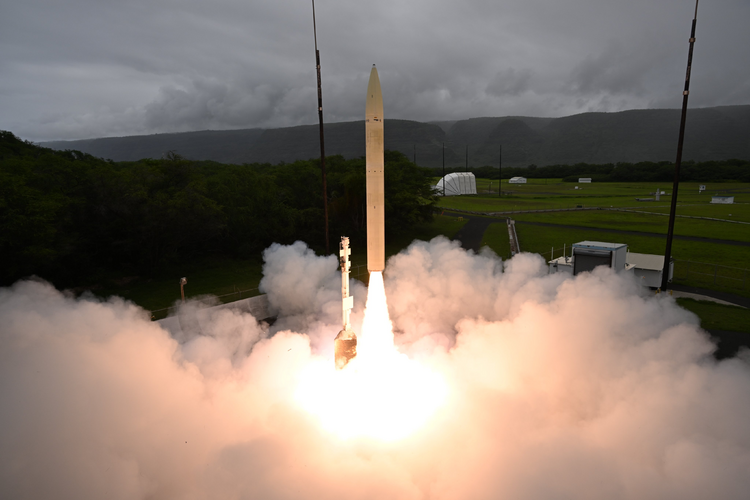Forest Green
ACCESS: Above Top Secret
- Joined
- 11 June 2019
- Messages
- 9,402
- Reaction score
- 17,134
MPBD
An air launched, highly classified hypersonic program.
Two stage rocket (from GD's booster size table, MPBD is 28x 126 size, which may be the fisrt stage size and is simmilar to ARRW size. But MPBD has two stage), second stage motor with TVC acs. Seems like a big strike missile.
Also, development is at least begin from 2018, and still continous now. Raytheon seeked program director through 2022.11-2023.3.
Update:
Raytheon still seeking for MPBD director on 2023/8/30








The money shot:Not that again. Once more, Boeing did not unveil anything. It's just a fan made animation of own amateur what-if project.
View: https://x.com/egpjet3d/status/1796169100709822846

Not that again. Once more, Boeing did not unveil anything. It's just a fan made animation of own amateur what-if project.
View: https://x.com/egpjet3d/status/1796169100709822846


The markings don't look final, but the hardware likely is.So those photographs show what the production CPS booster-stack will look like?
Yes. We've known this through the second picture in the tweet since [at least] last year.So those photographs show what the production CPS booster-stack will look like?
Imagine one of those launching from a Zumwalt...
Well... the original specification for CPS was 2000-3000nm (3700-5600km), but back then they were on about using a re-purposed Trident C4 with a stage removed or something.3500km? Has anyone crosschecked? I have a 10% higher value in latitude only (without even taking into consideration the longitudinal offset).

The Army has still not said how fast the C-HGB flew during Flight Experiment 2 or how far it traveled. The Pentagon has previously said that this weapon would allow the Army and Navy to “strike targets hundreds and even thousands of miles away” and that it will get up to a speed of Mach 17.


The booster stack is purpose built for the mission. The diameter of the booster is either 34.5” or 32.5”, I cannot remember off the top of my head.Anyone guessing or estimating the missile’s dimensions and if the booster stack is purpose built or an existing modified SRM.
If I missed this early my apologies.
Same as Trident: flash boil seawater with a gas generator and the steam produced yeets the missile. A fairly warm "cold" launch.Also, is the USN going to cold or hot launch them?

Diameter is 34.5in (876mm), the length is probably at least 10m. I had a diagram somewhere estimating length but the site search engine is currently broken.Anyone guessing or estimating the missile’s dimensions and if the booster stack is purpose built or an existing modified SRM.
If I missed this early my apologies.
but the site search engine is currently broken.
Yeah, what is up with that? I've been trying to find the PrSM thread.
Helps to cool down the gas generator exhaust, since that steam cannot easily exceed 100degC.Same as Trident: flash boil seawater with a gas generator and the steam produced yeets the missile. A fairly warm "cold" launch.
Would that fit into a Mk57 PVLS, or do we need to stick those into the VPMs?Diameter is 34.5in (876mm), the length is probably at least 10m. I had a diagram somewhere estimating length but the site search engine is currently broken.
VPMs only, 3 to a single VPM. Mk57 is only 710mm wide, and only 7.93m high.Would that fit into a Mk57 PVLS, or do we need to stick those into the VPMs?
Using this image on full size on a 27in monitor, I measured the width at 10.5mm and the length at 130mm. BUT, there is a slight slant here from top to bottom, so both estimates are conservative. Either way, it's about Pershing II height!Anyone guessing or estimating the missile’s dimensions and if the booster stack is purpose built or an existing modified SRM.
If I missed this early my apologies.


CPS All Up Round test was successful. Was launched from a stand rather than an Army or Navy launcher, but a good step. View: https://twitter.com/AirPowerNEW1/status/1806788817543963053?t=kFE5Et-P2PQ4j8fbMorCBw&s=19
It is significantly longer than you would expect for a traditional missile. CHGB drives the length of the nose cone/fairing. The initial test flights of the glide body were on significantly larger diameter launchers which partially/fully obfuscated the length of the glide body.Is it just me or is the nose cone far more streamlined than the renders? It is usually depicted as having a blunter nose optimized for underwater launch.
The US has reached a crucial milestone.
According to the Missile Defense Agency., the Defense Department’s advanced missile tracking satellites logged their first views of a hypersonic flight test.Hypersonic and Ballistic Tracking Space Sensor (HBTSS) satellites were able to track a hypersonic system.
MDA didn’t disclose the date of the flight, which took off from Wallops Island in Virginia.The agency said in a June 14 statement, “Initial reports show the sensors successfully collected data after launch. MDA will continue to assess flight data over the next several weeks.”
Viewers may note, that the Missile Defense Agency (MDA) and Space Development Agency (SDA) are actively working on components of a hypersonic missile defense system to protect against hypersonic weapons and other emerging missile threats. This includes developing the tracking and transport layers of the Proliferated Warfighter Space Architecture (PWSA) and various interceptor programs.
In this video, Defense Updates analyzes why successful tracking of hypersonic flight by US HBTSS satellites is a crucial development ?
Chapters:
00:11 INTRODUCTION
02:15 HYPERSONIC WEAPON
04:09 TRACKING HYPERSONIC THREATS
06:49 AID IN HYPERSONIC WEAPON TESTING
06:49 ANALYSIS
Do you have this full presentation?I've had this render since May 2021, which seems pretty close to the system as it entered service.
View attachment 733292
Interestingly that shot is around the same distance, 3700-3800km, although with a STARS-III (modded Polaris A-3) booster.


